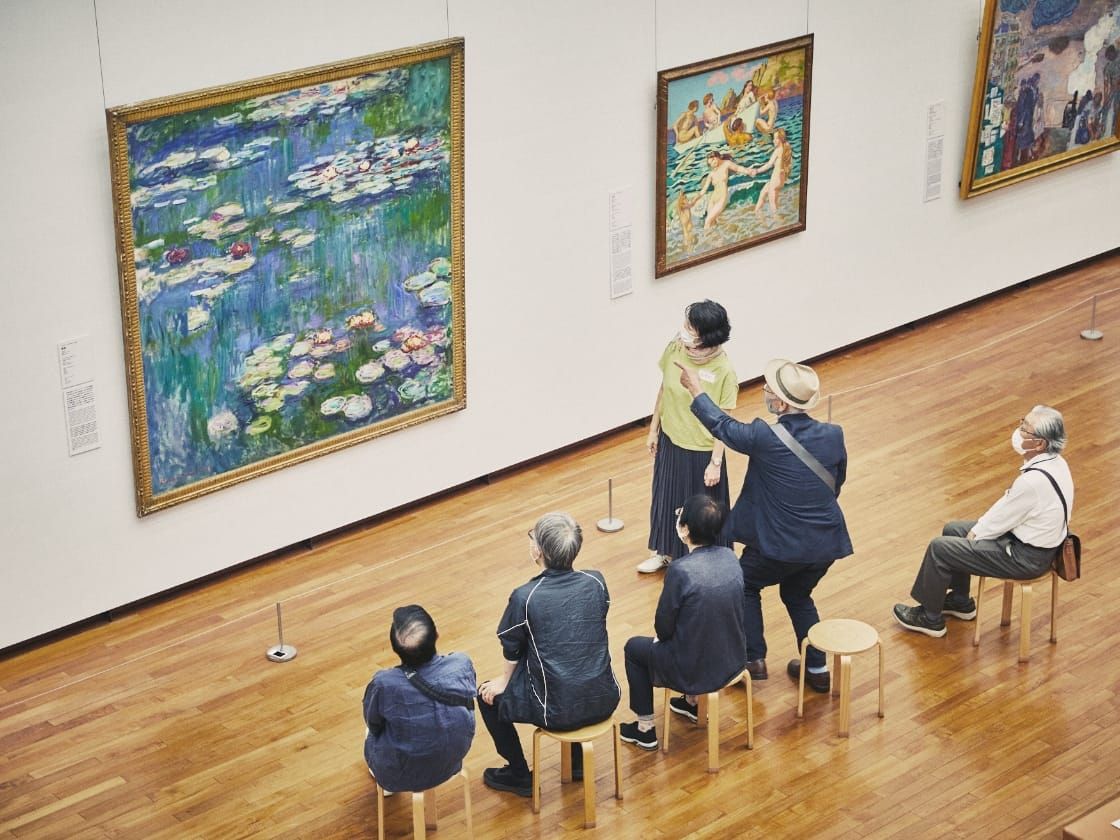My Favorite Piece: Collection Spotlight Vol. 2 Kumamoto Prefectural Museum of Art: Noda Hideo, School Life, 1937
A conversation with curator Yamanaka Risako

Noda Hideo, School Life (Piedmont High School mural), 1937
In this series, museum personnel shine a spotlight on favorite pieces from their own museum's collection, works that they hope everyone will see and appreciate. For this second installment, we spoke with Kumamoto Prefectural Museum of Art curator Yamanaka Risako. The museum collects a broad range of works by artists associated with Kumamoto Prefecture, aiming to construct a collection with systematic coverage of local art history.
Kumamoto Prefectural Museum of Art’s objective
- Curator Yamanaka Risako’s thoughts about her favorite piece
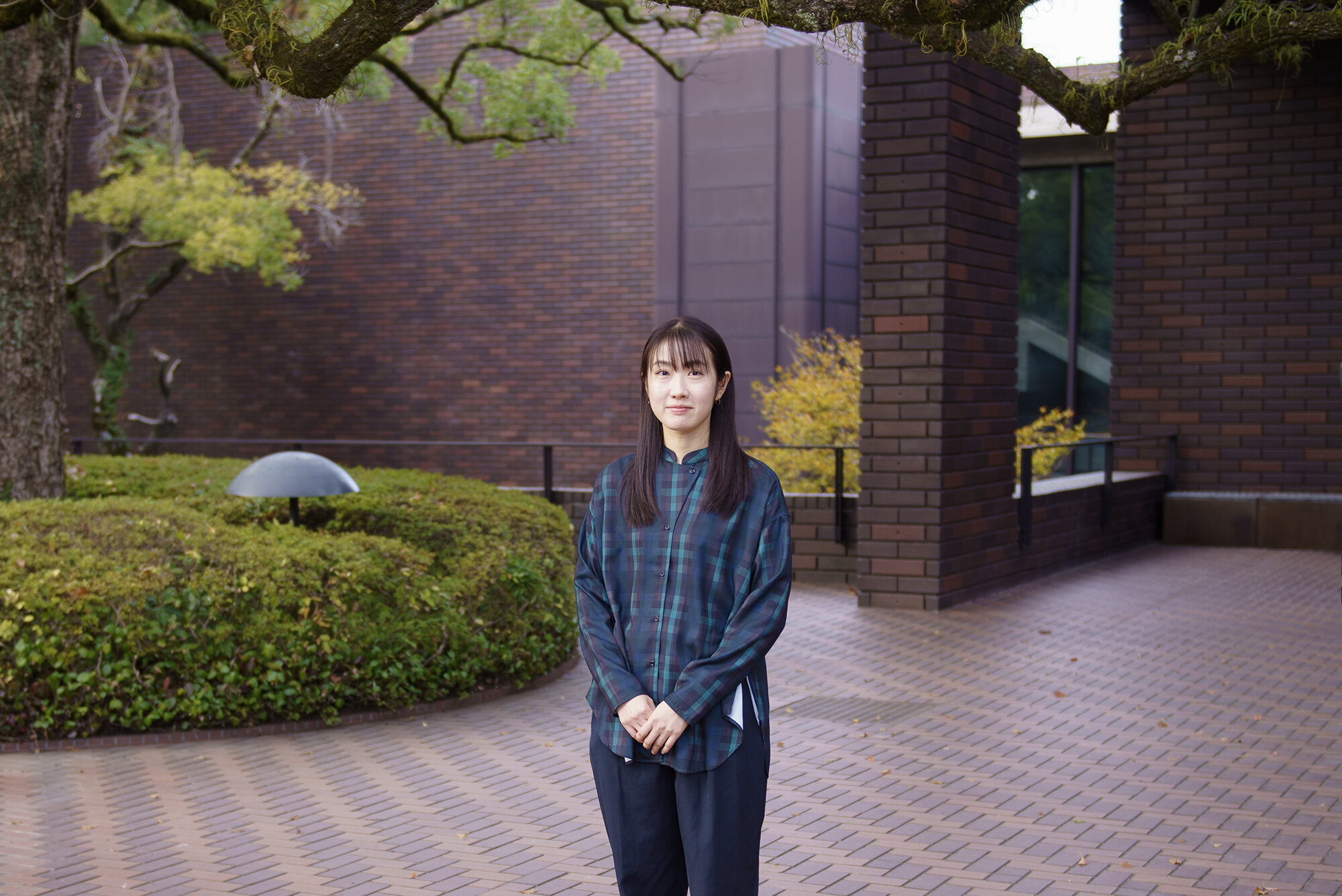
Curator Yamanaka Risako at the entrance to Kumamoto Prefectural Museum of Art
American high school mural in Kumamoto
The Kumamoto Prefectural Museum of Art opened in 1976 as a general art museum with a remit covering everything from ancient to contemporary art. It is located on the Ninomaru Square in the grounds of Kumamoto Castle, which has been designated a Special Historical Site by Japan. The distinctive museum building is considered one of the best examples of architecture by Maekawa Kunio. Maekawa was a disciple of Le Corbusier, and a leading proponent of Modernist architecture. He is known for the large number of architectural masterpieces that he completed around the world. The favorite piece introduced by curator Yamanaka Risako can be viewed in the atrium hall on floor B1 of the museum building.

Noda Hideo’s School Life mural (center) with Funakoshi Yasutake’s Spring from The Four Seasons in Eastern Hokkaido, 1977 (left).
Noda Hideo (Hideo Benjamin Noda) was born in California in 1908 to a family of Japanese immigrants. His parents came from Kumamoto, and they sent him back there as a child to receive a Japanese education. After graduating from the equivalent of high school in Japan, he returned to California and attended Piedmont High School in Oakland. After Piedmont, he entered the California School of Fine Arts (CSFA—later becoming the San Francisco Art Institute until its closure in 2022), majoring in fine arts. In his late twenties, Noda produced a mural for his high school, entitled School Life (Piedmont High School mural). Yamanaka explains the background to this project.
“Noda apparently became involved in producing the Piedmont High mural as a result of meeting Mexican muralist Diego Rivera, who created a large fresco at CSFA. Noda began working on murals, including serving as an assistant for Rivera’s mural at the Rockefeller Center in New York, which was destroyed after nearing completion. While he was pursuing his career in murals, he was persuaded by his high school art teacher to produce the mural at his old school.”
While working on a different mural, Noda is said to have fallen from his scaffold and sustained a head injury. He later died of a brain tumor, at that age of thirty-one, two years after completing his work at Piedmont High.
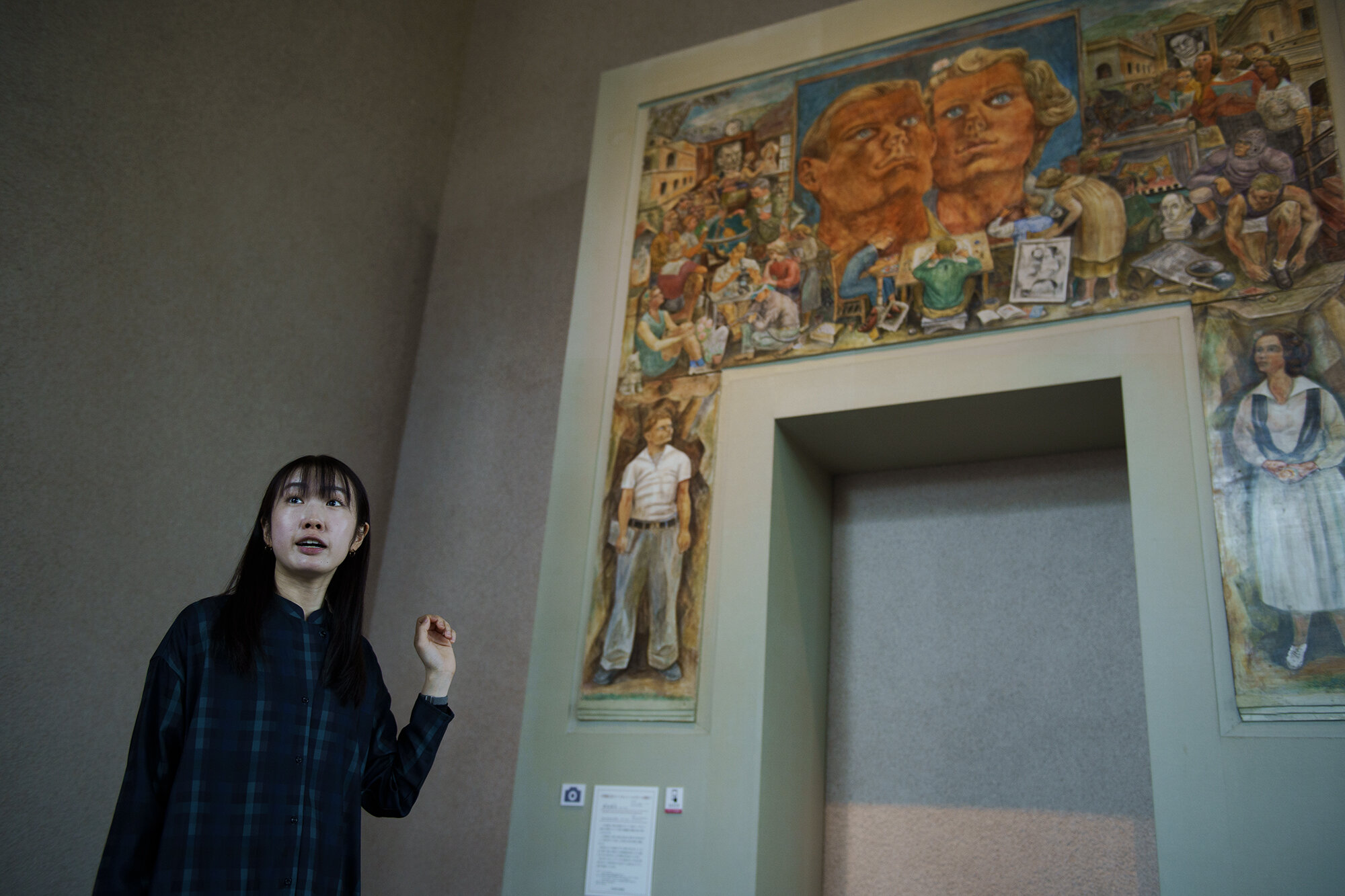
Curator Yamanaka Risako telling visitors about her favorite piece
Painted from the viewpoint of the two figures in the bottom parts of the mural
School Life was painted on the wall in a passage in the school library. In the top panel, on the right can be seen students involved in theater and musical performances, sports, and athletics. On the left there are students involved in a variety of studies, including using a globe and a microscope. “This approach of putting different scenes together to make a single picture is one of the distinctive features of Noda’s murals,” continues Yamanaka.
“The male and female figures painted on a large canvas in the center at the top are the first feature to catch the eye, and in the background is a depiction of the Bay Bridge that links San Francisco and Oakland. In this way, the mural combines school life with the natural features of California. The two figures in the lower panels seem to be looking up with the same perspective that we have as viewers of the mural. It is easy to imagine that Noda employed this device as a means of expressing the future potential of the young people, depicted by shifting the gaze from a narrow location to the expansive world beyond.”
In 1991, the mural and the wall it is painted on were taken down from Piedmont High School. The following year, they were added to the museum’s holdings in Kumamoto, where Noda had lived for many years.
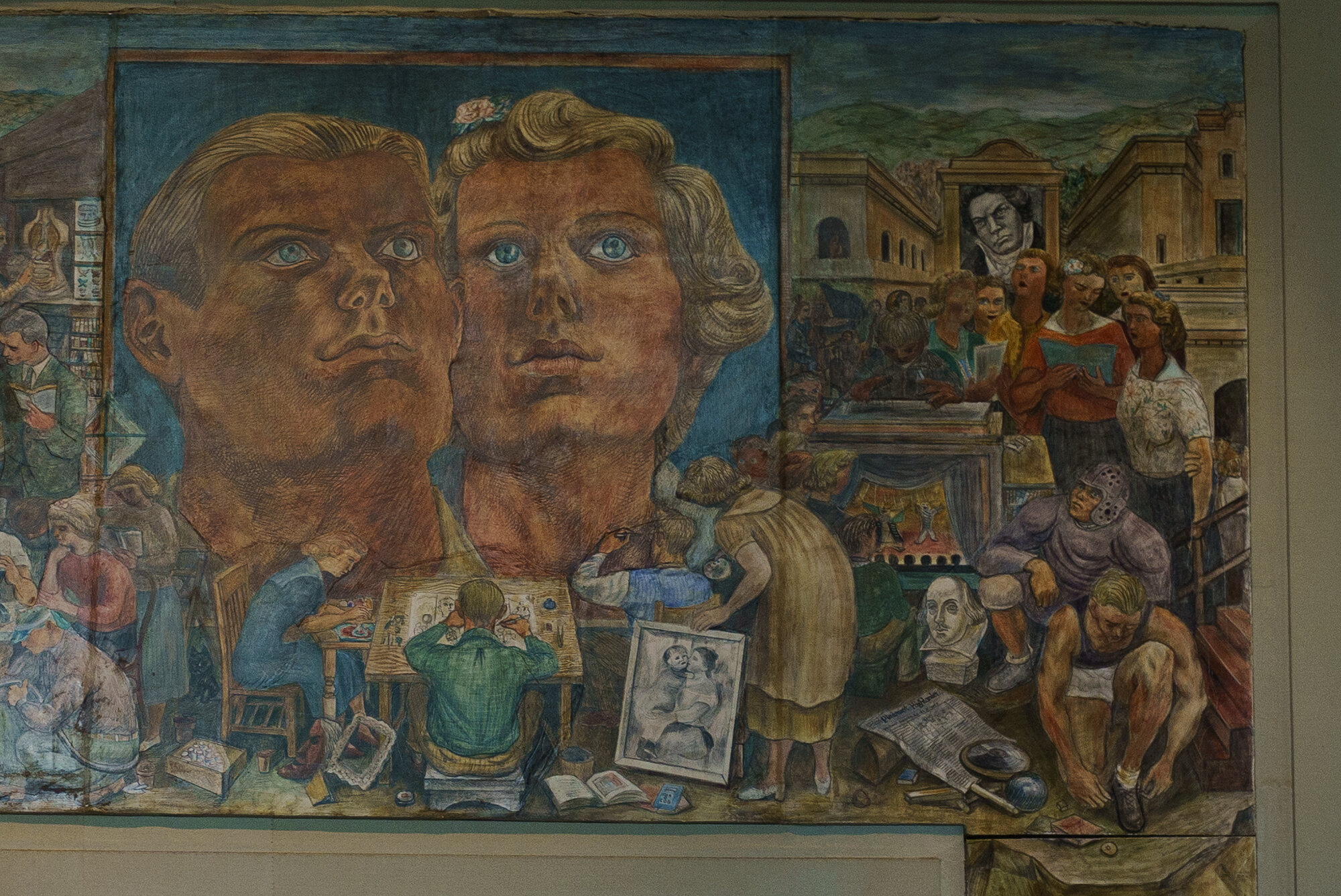
The woman holding a black-and-white work in the center is Noda’s high school art teacher, who was closely involved in the production of the mural. The figure working in front of her is said to be Noda himself.
Kumamoto Prefectural Museum of Art’s objective
In addition to School Life, Kumamoto Prefectural Museum of Art’s collection contains oil and watercolor paintings and drawings by Noda, amounting to 62 works in all. The collection also includes works by other artists who lived in Kumamoto, including Leonard Léonard Foujita. Yamanaka represented Kumamoto Prefectural Museum of Art on the curatorial team for the Adventures of Art in 20th Century—Appreciating Japanese and Western Artworks through Masterpieces, the exhibition that traveled to Kumamoto this summer (running from July 22 to September 18, 2023). The exhibition delighted and strongly resonated with museum visitors, revolving around works from the collection of National Museum of Modern Art, Tokyo, with the addition of works from the collections of Kumamoto Prefectural Museum of Art and the Takamatsu Art Museum.
Adventures of Art in 20th Century—Appreciating Japanese and Western Artworks through Masterpieces exhibition, Kumamoto Prefectural Museum of Art, 2023
“For the Kumamoto Prefectural Museum of Art, in addition to being able to exhibit nationally-designated important cultural properties and other works from the collection of the National Museum of Modern Art, Tokyo, it was a precious opportunity to be able to augment the exhibition with works from our own collection by artists such as Foujita, Otsuka Koji, and Hamada Chimei, demonstrating the place of these Kumamoto artists in modern and contemporary art history on a national and global scale. This sort of research in the genre of painting, however, serves as a reminder that there is still substantial scope for similar research in areas such as the history of photography and design in Kumamoto in the modern period. I am personally committed to deeper exploration in the areas of photography and design. As part of that effort, I have started investigating the work of Kono Asahachi, an artist born in Kumamoto in 1876, who traveled to America independently at the age of twenty-one and became involved in art photography, spending over thirty years in Los Angeles before returning to Japan in 1934.”

Kono Asahachi, Perpetual Motion, no date, Uki City Shiranuhi Museum
Kumamoto Prefectural Museum of Art organizes two special exhibitions and four collection exhibitions each year. The museum also has an annex where it presents a collection of exhibits related to the Hosokawa clan through a tie-up with Eisei Bunko Museum in Tokyo, which has holdings based on the collection by Hosokawa Moritatsu, the clan’s sixteenth head, enabling visitors to see exhibits of a different character to those the main museum.
“Inside the museum building, an array of bronze statues complements Maekawa Kunio’s modernist architecture, giving a special sense of a space that is out of the ordinary. But despite the special atmosphere that it engenders, we try to make the museum a place that encourages casual visits by lots of people. Many of the foreign tourists who visit Kumamoto Castle also take a look at the museum, so we provide tools that can be used with smartphones and other devices to enrich their experience. We are also actively involved in ensuring the museum is accessible to children who generally have few chances to see art, inviting elementary schools and junior high schools around Kumamoto Prefecture.”
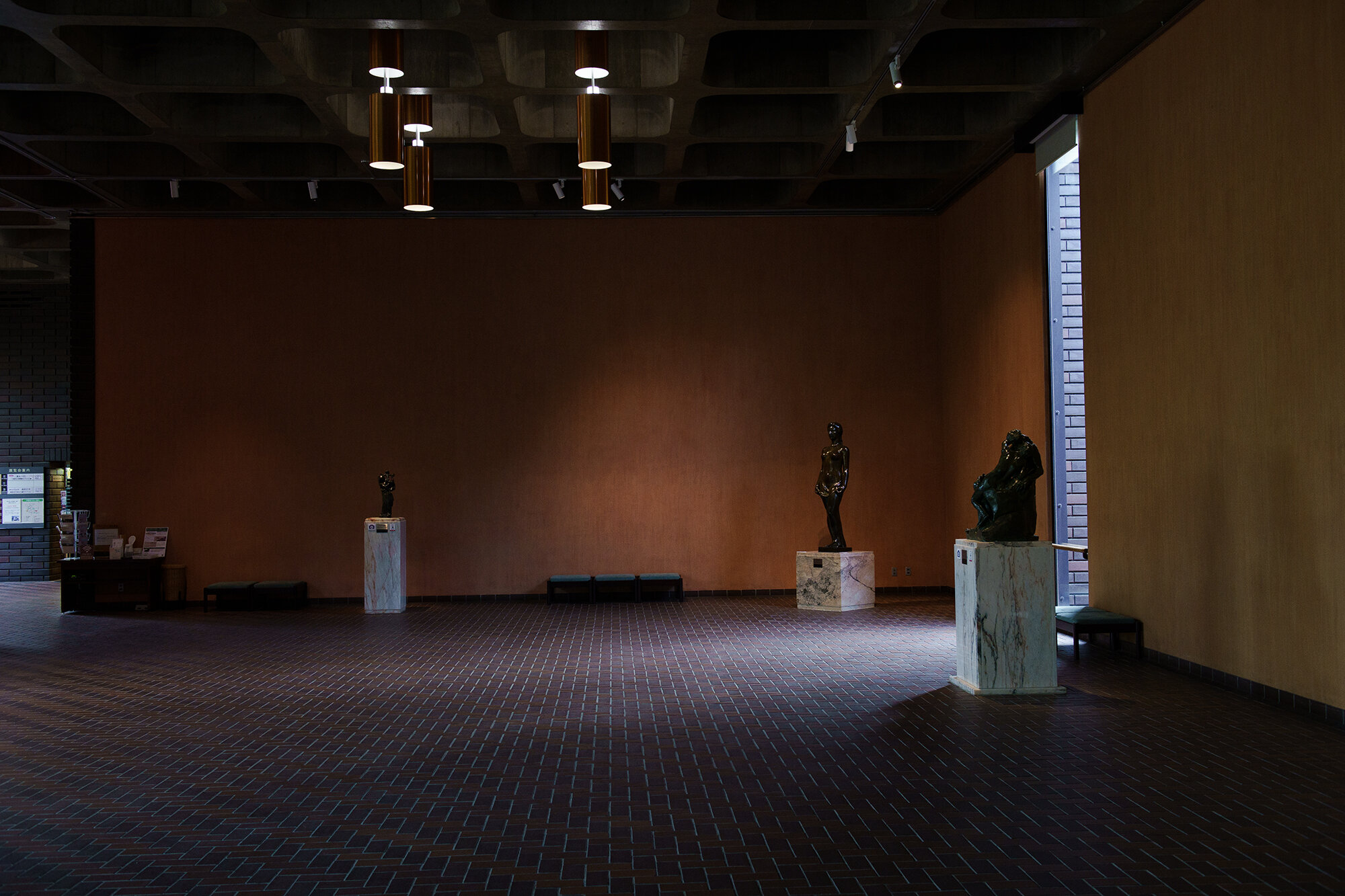
The museum’s ground floor lobby, where bronze statues are in harmony with the space designed by Maekawa Kunio
Curator Yamanaka Risako’s thoughts about her favorite piece
As her favorite piece, curator Yamanaka Risako chose Noda Hideo’s School Life. We asked her why this mural from the Piedmont High School was her favorite.
“Noda was born in America as the child of a family of immigrants, and he was brought up with dual nationality under complex circumstances. From his background of living in an American city as part of a colored population, Noda was particularly adept at painting the loneliness and sensitive mentality of people living in an urban context. He aspired to a society where people could live with equal standing, and joined in the activities of the American Communist Party. One of his paintings, for instance, picks up an actual case of discrimination to show a young black man arraigned on false charges. Even today, people who have been driven out of their home countries by war and other circumstances can be found around the world, and human rights issues involving migrants are in the news every day. Viewing Noda’s works with a knowledge of the artist’s background leads us to think about people in such circumstances, and wonder whether it was his background that gave Noda the ability to empathize with the gentle and vulnerable hearts of others.”
Listening to Yamanaka makes it clear how keen she is to further the museum’s objective of ensuring the continuation of its out-of-the-ordinary character close to the keep of Kumamoto Castle at the same time as maintaining an easy-to-relate-to nature that is welcoming to both Kumamoto citizens and people from elsewhere. Kumamoto Prefectural Museum of Art has installed Noda Hideo’s School Life so that it can be viewed in an awe-inspiring architectural space, raising expectations for future exhibitions at the museum and for further development of its collection.
Yamanaka Risako
Yamanaka Risako was born in Fukuoka Prefecture in 1992, and has worked as a curator at Kumamoto Prefectural Museum of Art since 2020, specializing in modern and contemporary art.

Kumamoto Prefectural Museum of Art
2 Ninomaru, Chuo-ku, Kumamoto City, Kumamoto Prefecture
https://www.pref.kumamoto.jp/site/museum/ (Japanese)
Report/interview and photographs by Nakajima Ryohei







